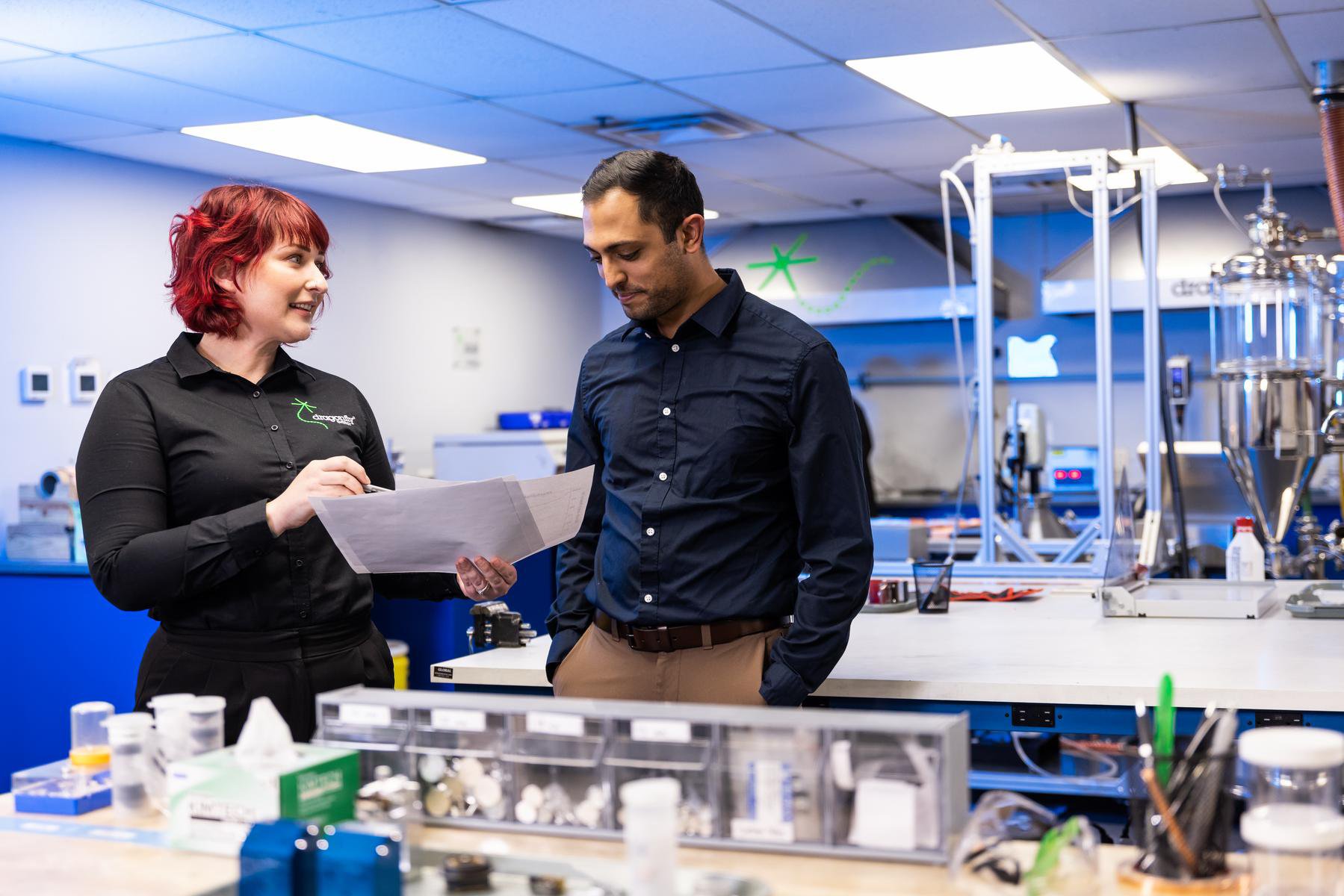Energy and sustainability are two heavy-weight buzzwords in today’s discourse. We’re constantly discovering new ways to innovate and generate power to keep our growing population moving. Batteries play a critical role in that process by powering our electronic devices, propelling electric vehicles, and providing both off-grid and backup power to our homes.
The largest battle facing our sustainability goals centers on how best to use renewable energy in our cars, campers, homes, and businesses. While fossil fuels won’t be going anywhere anytime soon, it is our global goal to phase them out over the next several decades. As a result, we’ll need reliable systems for storing and using renewable power. And that’s where lithium-ion battery technology comes into play. The key is ensuring that the production of said batteries is as sustainable as the intermittent renewable energy they’ll be helping to harness.
Let’s look at how lithium-ion batteries and fossil fuels compare and contrast on a sustainability level. Is the sourcing, building, and disposal of lithium-ion batteries better for the environment compared to what we’re currently doing with fossil fuels? Where are we sourcing the materials? What impact are they having on the environment? And what—if any—effect will pivoting toward sustainability have on the economy?
Understanding Lithium-ion Batteries

For more than a century, the lead-acid battery dominated the rechargeable battery sphere. Then, in the 1970s, the first breakthroughs in lithium-ion (sometimes shorthanded as Li-ion) research changed how we look at energy and sustainability. Twenty years later, the first lithium-ion battery came to market, and we’ve been improving upon the technology ever since.
Today, lithium-ion batteries are used across diverse industries, depending on their needs. From EVs to energy storage, lithium-ion batteries help reduce the amount of fossil fuels we use while boosting our ability to harness renewable energy.
Every lithium-ion battery contains an anode, cathode, separator, electrolyte, and two current collectors (positive and negative). Lithium metal is stored in the anode and cathode. Then, the battery uses an electrolyte to carry positively charged lithium ions from the anode to the cathode. This provides energy and allows whatever the battery is powering to function.
Those ions, however, deplete. And this is where the rechargeability of lithium-ion batteries ultimately changed the world. The electrolyte carries the lithium ions from the cathode back to the anode, which recharges the battery.
Energy Sustainability Goals
Regarding sustainability, we see the greatest energy advancements in the motor vehicle industry. It’s widely anticipated that the internal combustion engine will be phased out in favor of battery-powered vehicles in the coming decades.
Energy storage is equally critical to attaining global sustainability goals. Lithium-ion batteries allow us to store renewable energy and use it when needed. For example, solar panels on your RV can turn sunlight into renewable energy. That energy gets stored in a battery that kicks in when the sun goes down. Therefore, instead of running your gas-burning generator, your RV can sustain itself with solar power and batteries.
According to the World Economic Forum, the demand for lithium-ion batteries has ballooned exponentially over the past decade. In 2010, demand was roughly 0.5 GWh (GigaWatt hours). Today, it’s over 526 GWh.
Lithium-ion batteries can (and will) replace fossil fuels in the future. They’ll do this in two critical ways: storage for the grid and charging stations for EVs.
Regarding the grid, li-ion batteries will play a critical role due to their ability to store power during periods of low usage. Consider how homes in colder regions will likely use more electricity between December and March than between April and June. Renewables and the energy stored in batteries can fulfill high power demand. Then, when demand subsides, they can recharge on solar, wind, or hydropower energy.
EVs benefit similarly. Owners can rely on renewables and stored energy to recharge their vehicles instead of fossil fuels.
Lithium-Ion Vs. Other Rechargeable Energy Sources
Lithium-ion batteries aren’t the only rechargeable energy sources on the market. You have nickel-cadmium, nickel-metal-hydride, and the classic lead acid. Lithium-ions, however, have significant advantages over all three.
For starters, they have one of the highest energy densities of commercial battery technology—about 300 watt-hours per kilogram (Wh/kg). Compare that to 75 Wh/kg from other battery technologies, and you can see why Li-ion is the superior choice.
Voltage-wise, a single lithium-ion cell can produce a voltage of 3.6 or higher, which is between one-and-a-half and three times more voltage than alternative energy solutions. It’s why Li-ion is the go-to choice for high-power needs and energy sustainability and storage for the grid and more.
Finally, lithium-ion batteries are incredibly low-maintenance. They last substantially longer than other batteries and don’t contain toxic materials such as lead.
Fossil Fuels: The Traditional Energy Source

The human race has relied on fossil fuels for well over a century. From man-powered oil drills in Titusville, Pennsylvania to oil fields in the Middle East, fossil fuels have come a long way in powering life on Earth. And oil is only the beginning.
Coal and natural gas are two critical pillars (oil being the third) of the fossil fuel industry. Today, all three combine to serve about 80% of our energy needs. Although fossil fuels have driven immense socioeconomic progress, they pose a major risk to our future. Air pollution, water pollution, and global warming are only the tips of the melting iceberg.
Oil, Coal, and Natural Gas
The three categories of fossil fuels comprise oil, coal, and natural gas. How do these differ from one another?
Petroleum (crude oil) is the thick black liquid buried deep in the earth. It’s made mostly of hydrocarbons (a mix of hydrogen and carbon compounds). As organic matter died on the ocean floor, it was covered and crushed by sediment over millions of years. The earth changed. Oceans became deserts. Then humans arrived to dig it all up.
After extraction, oil is brought to refineries and turned into fuels like propane, gasoline, and kerosene. We also use it to make plastic and paint.
Coal is a carbon-heavy rock we source from mines around the world. But not all coal mining is deep underground. In fact, strip mining—the removal of surface layers of soil and rock to access the coal beneath—accounts for two-thirds of coal sourced in the United States. It’s unfortunate, because strip-mining uproots entire ecosystems and is particularly destructive.
That said, we have come a long way in terms of “clean coal” technologies. Although coal washing has been standard practice in developed nations for some time, these days “clean coal” technology typically refers to carbon capture and storage (CCS). This effectively removes the CO2 released when burning coal. It’s a step in the sustainability direction, but there are cleaner sources of energy we can still leverage.
Finally, natural gas is the third kind of fossil fuel we’ll find underground. Conventional gas is found among oil deposits via drilling. Unconventional gas requires special stimulation, such as fracking, to extract. In the United States, natural gas—mostly sourced through fracking—provides 38% of our energy needs.
Availability and Extraction
Unfortunately, our most widely used energy sources don’t simply fall from the sky. The process of extracting lithium and fossil fuels comes at a price. Determining which is better for the environment requires a deeper understanding of how both are acquired.
We lean on two types of mining to obtain lithium for Li-ion batteries:
- Brine extraction is the process of pumping underground saline water into vast evaporation ponds. From there, the water evaporates, leaving behind salts rich in lithium. The main concern with brine extraction is the large amount of water required. This can strain local water sources and harm surrounding ecosystems. In addition, the evaporation process can release harmful toxins and greenhouse gases (GHGs) into the air.
- Open-pit mining requires blasting, drilling, and hard human labor to extract lithium-bearing ore. It can lead to habitat destruction, deforestation, and soil erosion. Thankfully, advancements in mining technology and regulations have made strides in mitigating these impacts and promoting sustainable mining practices.
To meet sustainability goals, we need to strike a balance between energy sourcing and renewable advancements. It takes millions of years for fossil fuels to form beneath the surface. We’ll extract it all long before it replenishes itself. Granted, there’s also a finite amount of lithium in the ground, but we have the technology to make that lithium last much longer—if not in perpetuity. Think of it this way: once you burn gas, it’s gone. Meanwhile, you can recharge a battery multiple times.
Environmental Impact
The environmental impacts of fossil fuel extraction are impossible to ignore. Nobody can look at a coal mine and think, “that sure looks good for the planet.”
Extracting, refining, and burning fossil fuels goes beyond the mine and processing plant. The industry leases swathes of land for facilities, access roads, wells, waste storage, and pipes—all built and powered by fossil fuels. To extract coal, they’ll level entire forests or blast away mountains that have stood for millennia.
Oil, gas, and coal production and extraction also endanger our natural water systems. Toxic runoff from coal mining can seep into rivers and streams. Oil spills and leaks can pollute multiple square miles of ocean, causing untold harm to marine and bird life. We all remember the BP oil spill and the images of birds and fish covered in black sludge. Furthermore, fracking has been found to contaminate drinking water. Then, there’s the often-overlooked social impact of mining, such as the displacement of local communities.
That said, lithium extraction also has its issues. Think of all the machines that rely on fossil fuels to keep the lithium mines operating. Just like coal mines, lithium mines can pose a threat to the natural environment. Brine extraction strains local water sources, while soil erosion may lead to long-term ecological damage. Moreover, most of our primary sources of lithium come from underdeveloped parts of the world, where wages are low and working conditions bad.
Batteries will eventually die. This leads to new challenges regarding reusing and recycling. Fortunately, there are avenues for mitigating any hazardous effects. For example, AI-powered sorting systems can identify battery types and categorize them with high levels of accuracy. This makes the recycling process a lot easier, ensuring that batteries with similar components are disposed of and recycled properly.
Energy Efficiency and Conversion
Sustainability equals energy efficiency, and storage is the name of the game. No energy source performs better than the lithium-ion battery.
This is because battery storage helps relieve strain on the grid. Batteries can easily integrate with existing networks to store excess power. Then, they release that power when needed; for instance, in the winter, when more people use electricity to heat their homes. Batteries will also smooth our transition into a carbon-neutral future.
Efficient storage solutions are critical for change. For the longest time, conventional energy was more competitively priced. Thankfully, we’ve seen shifts toward more affordable renewables. Now, electrical utilities can increasingly pivot their systems to carbon-free alternatives.
It’s these utility systems that are crucial to achieving sustainability goals. We can all switch to electric cars, but if the systems to charge them still rely on fossil fuels, how much have we actually improved?
Studies have found that we can reduce carbon emissions by between 50% and 80% by transitioning to solar and wind sources coupled with proper storage (i.e., lithium-ion batteries). While we aren’t there yet, the Li-ion future is on the horizon—largely as a result of continued R&D efforts into renewable energy storage solutions.
For example, Dragonfly Energy’s proprietary dry electrode battery manufacturing process can produce batteries across various lithium chemistries, including NMC, LFP, and LCO. Their patented process produces a significantly smaller manufacturing footprint while consuming less power than traditional methods.
Economic Impact and Cost
It’s true that, at their inception, lithium-ion batteries were far more expensive than conventional fossil fuel solutions. That’s because the fossil fuel industry has benefited from existing infrastructure and economies of scale regarding production and distribution. However, the hidden costs of climate change and pollution are becoming ever-more apparent.
As research continues and adoption becomes more widespread, the cost of renewables has dropped. We’re seeing more and more industries pivot to electricity as a result. A case in point is the heavy-duty trucking industry, which has embraced the electronic future in the face of stricter regulations. They rely on the latest technology, such as Dragonfly Energy’s Battle Born All-Electric APU, to mitigate idling during rest periods as drivers bring heavy-duty cargo from coast to coast.
But although many are willing to adopt renewables, some major players still rely on low-cost fossil fuels to run their day-to-day operations. This is especially true in the transport and energy sector due to their high energy needs, established extraction and processing systems, and relatively low costs. However, the high environmental price tag has compelled global governments to unite and pursue a net-zero economic model.
Net zero simply means striking a balance between GHGs produced through human activity and those captured by nature or other technological means. Lithium-ion batteries are the key to achieving global goals of adopting renewable power and electric mobility, while playing a crucial part in developing a circular economy.
Lithium-Ion and the Future of Energy
Fossil fuels got us where we are today, but now it’s up to humans to pave a cleaner path toward sustainability through renewable energy. Lithium-ion batteries will be front and center in this transition, but it won’t come without some challenges. If we can clean up our lithium mining practices, we can expect to see drastic reductions in its environmental impact.
It’s clear that renewable energy and robust storage solutions are significantly cleaner than fossil fuel alternatives. Still, there’s plenty of room for improvement—especially when it comes to production and processing.

Companies like Dragonfly Energy know that better than anybody. Every day, we make new strides toward improved storage capacity and energy efficiency. If you’re looking to pivot away from fossil fuels, get in touch with Dragonfly Energy to learn more about powering your home, RV, and boat with sustainable lithium-ion batteries.


